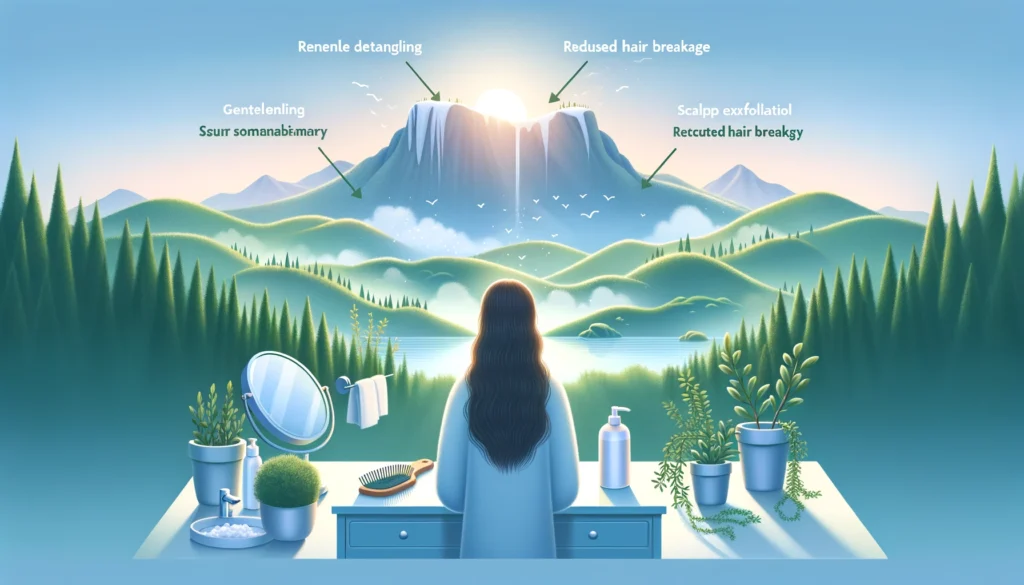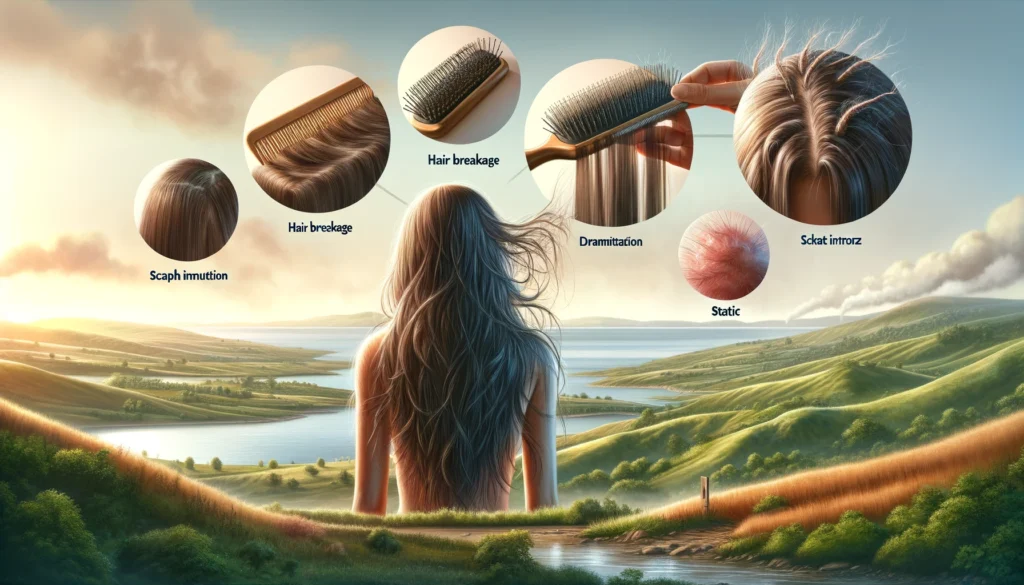The quest for longer, healthier hair often leads to a myriad of questions about the best care routines. One such question is whether brushing your hair can stimulate hair growth.
This article explores the science behind hair brushing, its benefits, potential drawbacks, and how to properly care for your hair to promote growth.
Understanding Hair Growth
Delving into the anagen, catagen, and telogen phases unravels the complex cycle of hair growth. The anagen phase, or growth phase, marks a period of active hair production, significantly influenced by genetics, health, and diet. Transitioning into the catagen phase, a transitional phase, hair prepares to enter telogen, the resting phase, concluding the cycle.
These stages underscore the vital impact of both intrinsic factors like genetics and health, alongside extrinsic ones such as diet and hair care practices, on the rate of hair growth. This holistic view emphasizes the nuanced interplay between our biological blueprint and lifestyle choices in fostering optimal hair health.
The Role of Scalp Health in Hair Growth
Maintaining scalp health is paramount for optimal hair growth. A healthy scalp fosters the environment necessary for hair to flourish. By ensuring good blood circulation, the scalp receives the nutrients and oxygen needed for hair follicles to thrive. Proper cleanliness of the scalp helps in preventing buildup, which can clog hair follicles and impede growth.
Achieving a balance in natural oils is also critical; these oils protect and nourish both the scalp and hair health, without leading to excess oiliness or dryness. The impact of a well-cared-for scalp on hair growth cannot be overstated, emphasizing the importance of scalp care in any hair care routine.
The Science of Brushing
Brushing your hair might seem like a purely aesthetic practice, but it also has potential benefits for hair growth, primarily through the mechanisms of scalp stimulation and the distribution of natural oils.
Scalp Stimulation
Gently brushing your hair not only detangles but also plays a critical role in stimulating the scalp. This stimulation is believed to improve blood circulation within the scalp, with the increased blood flow effectively delivering essential nutrients and oxygen to the hair roots.
This process is fundamental in supporting the hair growth process, as follicles receive the nourishment they need to thrive. While the act of brushing is simple, its impact on the scalp’s health and, consequently, on hair growth, is significant, making it a beneficial practice for those looking to enhance the health and appearance of their hair.
Distribution of Natural Oils
Brushing your hair is not just about detangling; it plays a crucial role in the distribution of natural oils from the scalp. The sebum, or natural oil produced by your scalp, is essential for keeping hair moisturized. When you brush, you help to distribute this sebum along the hair shaft, from root to tip.
This action doesn’t just reduce frizz; it also helps to create a protective layer over your hair. This protective layer is vital for maintaining a healthier scalp and hair. By ensuring that each strand is well-coated with sebum, brushing can potentially lead to faster-growing hair.
The consistent distribution of oils through brushing ensures that your hair remains lustrous, strong, and more manageable, laying the foundation for optimal growth conditions.
Potential Benefits of Hair Brushing
- Enhanced Hair Texture: Regular brushing can make hair smoother and more manageable.
- Reduced Breakage: Proper brushing techniques can help prevent hair breakage by removing tangles gently.
- Scalp Exfoliation: Brushing can help remove dead skin cells from the scalp, reducing dandruff and promoting a healthier scalp environment.

Risks and Drawbacks
Despite the potential benefits, excessive or improper brushing can have detrimental effects on hair health.
- Hair Breakage: Over-brushing or using a brush with harsh bristles can lead to breakage, especially when hair is wet and vulnerable.
- Scalp Irritation: Vigorous brushing can irritate the scalp, leading to sensitivity or even hair loss.
- Static and Frizz: Excessive brushing can strip hair of its natural oils, leading to static and frizz.

Best Practices for Hair Brushing
To harness the potential benefits of hair brushing without causing damage, follow these best practices:
Choose the Right Brush
To optimize hair health and potentially encourage growth, choosing the right brush plays a pivotal role. A tool with natural bristles is superior for distributing oils from the scalp through the length of your hair, enhancing its smoothness and shine. These bristles are often rounded at the tips, providing a gentle massage to the scalp that can stimulate blood flow, a key factor in nourishing hair follicles.
In contrast, synthetic brushes might be harsher on your scalp and strands. For those with tangled locks, wide-tooth combs offer a safer detangling solution, minimizing breakage and stress on the hair. Always prioritize tools that show kindness to your hair’s natural structure and integrity to foster a healthier growth environment.
Be Gentle
When it comes to nurturing your hair and potentially stimulating growth, brushing plays a pivotal role. However, the technique and care with which you brush can significantly influence its effectiveness. Be Gentle is the cornerstone of proper hair brushing. Starting from the ends and gradually working your way up to the roots ensures that tangles and knots are addressed with minimal tension, effectively minimizing breakage.
Employing a gentle stroke while brushing not only respects the delicate nature of your hair strands but also encourages a healthier scalp environment, paving the way for potential growth enhancement. Remember, the aim is to nurture, not battle, your hair.
Limit Brushing Frequency
Limit Brushing Frequency to avoid over-brushing. For most hair types, brushing once or twice a day is sufficient. Over-brushing can lead to damage and breakage, counteracting any benefits brushing might have on stimulating hair growth. Understanding your hair’s unique needs is crucial to adopting a brushing routine that promotes health and growth without causing unnecessary stress to your hair fibers.
Keep Your Brush Clean
It’s essential to regularly remove stray hairs from your brush and clean it thoroughly. This step helps prevent the buildup of oils and product residue, ensuring that every stroke through your hair contributes to its health and cleanliness rather than detracting from it. Brushing with a clean tool is not only about hygiene but also about maximizing the benefits of this simple yet effective hair care routine.
Check similar article: Does the Sun Help Your Hair Grow?
Frequently Asked Questions
Does brushing your hair make it grow faster?
Brushing your hair doesn’t directly increase the speed of hair growth but can promote a healthier scalp and distribute natural oils through your hair, indirectly supporting healthier growth conditions.
How often should I brush my hair for optimal growth?
Brushing once or twice a day is sufficient for most hair types. Over-brushing can damage the hair and scalp, so moderation is key.
What type of brush is best for hair growth?
Brushes with natural bristles or smooth, rounded synthetic bristles are ideal as they gently massage the scalp and distribute oils without causing damage.
Can brushing your hair too much cause hair loss?
Yes, excessive brushing can lead to hair breakage and loss by stressing the hair strands and irritating the scalp.
Is it better to brush hair wet or dry to promote growth?
It’s better to brush your hair when it’s dry. Wet hair is more vulnerable to damage and breakage. If you must detangle wet hair, use a wide-tooth comb and be gentle.
How does brushing distribute natural oils, and why is it beneficial?
Brushing from the scalp to the ends helps spread the scalp’s natural oils (sebum) along the hair shaft, moisturizing the hair, reducing frizz, and protecting against external damage, thus promoting healthier hair.
Can the direction of brushing affect hair growth?
There’s no scientific evidence that the direction affects growth. However, brushing from roots to ends can help prevent tangles and breakage.
Does scalp stimulation from brushing really improve hair health?
Gentle scalp stimulation through brushing can increase blood circulation, potentially improving nutrient delivery to hair follicles, which may support hair health.
What is the best way to brush hair to avoid damage?
Start by detangling the ends, then gently work your way up to the roots. Use a high-quality brush and avoid pulling or yanking to minimize damage.
Are there any specific brushing techniques that promote hair health?
Yes, using a soft-bristled brush, brushing gently in sections, and not overdoing it are key techniques. Additionally, cleaning your brush regularly to prevent the buildup of hair products and dead skin can also contribute to overall hair health.
Conclusion
While the act of brushing your hair does not directly stimulate growth, it plays a crucial role in maintaining a healthier scalp and stronger hair. By gently and effectively utilizing the right tools and techniques, brushing becomes an indirectly supporting part of a comprehensive hair care routine.
Proper brushing can help you achieve and maintain a healthy, vibrant look. It’s about enhancing the overall condition of your hair and scalp, which, in turn, supports hair health and can lead to better growth patterns over time.
